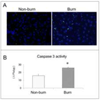Hepatic autophagy after severe burn in response to endoplasmic reticulum stress
- PMID: 24209807
- PMCID: PMC4169053
- DOI: 10.1016/j.jss.2013.09.042
Hepatic autophagy after severe burn in response to endoplasmic reticulum stress
Abstract
Background: Previous studies showed that liver dysfunction develops soon after severe burn, and this is associated with activation of endoplasmic reticulum (ER) stress. Autophagy is a catabolic process to maintain cellular organelle balance; ER stress is associated with autophagy signaling cascades. We thus sought to determine whether autophagy signals were associated with damage in the liver after burn, and further whether burn-associated ER stress activates autophagy signals in hepatocytes.
Methods: C57BL/6 male mice received a 25% total body surface area full-thickness scald burn, and liver was harvested at 24 h after burn. HepG2 cells were stimulated with an ER stress inducer thapsigargin (TG) for 24 h to mimic ER stress in vitro. Terminal deoxyuridine nick-end labeling staining was performed on histologic sections of liver. Autophagy was assessed by immunoblotting. Statistical analysis was performed using the Student t-test and significance was accepted at P < 0.05.
Results: Terminal deoxyuridine nick-end labeling positive-stained hepatocytes increased in burned animals with a significant elevation of caspase 3 activity (P < 0.05). Hepatic autophagy-related (ATG) protein 3, ATG5 and light chain (LC) 3B elevated significantly in burn animals as well (P < 0.05). Expression of Beclin-1, LC3A, and LC3B increased in HepG2 cells in response to TG, similar to the response seen in vivo. Cytosolic adenosine triphosphate dropped significantly, and adenosine monophosphate-activated protein kinase (AMPK) and mammalian target of rapamycin (mTOR) were phosphorylated as well in response to TG (P < 0.05).
Conclusions: ER stress, which occurs in hepatocytes after severe injury, is associated with autophagy and liver damage after severe burn. In response to ER stress, activated autophagy is associated with adenosine monophosphate-activated protein kinase and mammalian target target of rapamycin pathway.
Keywords: Apoptosis; Autophagy; Endoplasmic reticulum (ER); Mouse liver; Thermal injury.
Copyright © 2014 Elsevier Inc. All rights reserved.
Figures




Similar articles
-
Hepatic apoptosis postburn is mediated by c-Jun N-terminal kinase 2.Shock. 2013 Feb;39(2):183-8. doi: 10.1097/SHK.0b013e31827f40ab. Shock. 2013. PMID: 23324888 Free PMC article.
-
Severe burn-induced endoplasmic reticulum stress and hepatic damage in mice.Mol Med. 2009 Sep-Oct;15(9-10):316-20. doi: 10.2119/molmed.2009.00048. Epub 2009 Jun 19. Mol Med. 2009. PMID: 19603103 Free PMC article.
-
Role of autophagy and its molecular mechanisms in mice intestinal tract after severe burn.J Trauma Acute Care Surg. 2017 Oct;83(4):716-724. doi: 10.1097/TA.0000000000001624. J Trauma Acute Care Surg. 2017. PMID: 28930963
-
Autophagy and apoptosis in liver injury.Cell Cycle. 2015;14(11):1631-42. doi: 10.1080/15384101.2015.1038685. Cell Cycle. 2015. PMID: 25927598 Free PMC article. Review.
-
Endoplasmic reticulum stress is the crossroads of autophagy, inflammation, and apoptosis signaling pathways and participates in liver fibrosis.Inflamm Res. 2015 Jan;64(1):1-7. doi: 10.1007/s00011-014-0772-y. Epub 2014 Oct 7. Inflamm Res. 2015. PMID: 25286903 Review.
Cited by
-
Glutamine sustains energy metabolism and alleviates liver injury in burn sepsis by promoting the assembly of mitochondrial HSP60-HSP10 complex via SIRT4 dependent protein deacetylation.Redox Rep. 2024 Dec;29(1):2312320. doi: 10.1080/13510002.2024.2312320. Epub 2024 Feb 8. Redox Rep. 2024. PMID: 38329114 Free PMC article.
-
MiR-183-5p inhibitor promotes mitoxantrone-induced immunogenic death of hepatoma cells by targeting STC1.Int J Clin Exp Pathol. 2025 Jul 15;18(7):351-363. doi: 10.62347/ZPFV7918. eCollection 2025. Int J Clin Exp Pathol. 2025. PMID: 40814561 Free PMC article.
-
Burn-induced muscle metabolic derangements and mitochondrial dysfunction are associated with activation of HIF-1α and mTORC1: Role of protein farnesylation.Sci Rep. 2017 Jul 26;7(1):6618. doi: 10.1038/s41598-017-07011-3. Sci Rep. 2017. PMID: 28747716 Free PMC article.
-
The changes and prognostic value of liver function in young adults with severe burn: A retrospective observational study.Medicine (Baltimore). 2018 Dec;97(51):e13721. doi: 10.1097/MD.0000000000013721. Medicine (Baltimore). 2018. PMID: 30572508 Free PMC article.
-
Severe burn increased skeletal muscle loss in mdx mutant mice.J Surg Res. 2016 May 15;202(2):372-9. doi: 10.1016/j.jss.2016.02.037. Epub 2016 Mar 4. J Surg Res. 2016. PMID: 27229112 Free PMC article.
References
-
- Ding HQ, Zhou BJ, Liu L, Cheng S. Oxidative stress and metallothionein expression in the liver of rats with severe thermal injury. Burns : journal of the International Society for Burn Injuries. 2002;28:215–221. - PubMed
-
- Lai E, Teodoro T, Volchuk A. Endoplasmic reticulum stress: signaling the unfolded protein response. Physiology (Bethesda) 2007;22:193–201. - PubMed
Publication types
MeSH terms
Grants and funding
LinkOut - more resources
Full Text Sources
Other Literature Sources
Medical
Research Materials
Miscellaneous

